A hardwaresoftware approach to molecular dynamics on reconfigurable computers
九年级英语科技应用单选题50题
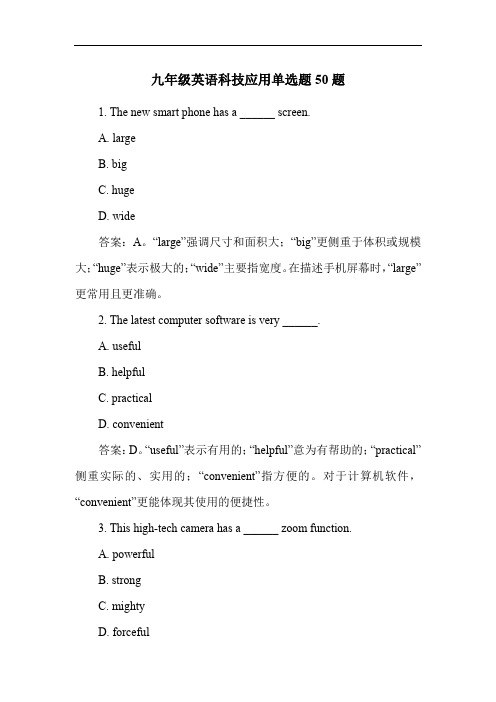
九年级英语科技应用单选题50题1. The new smart phone has a ______ screen.A. largeB. bigC. hugeD. wide答案:A。
“large”强调尺寸和面积大;“big”更侧重于体积或规模大;“huge”表示极大的;“wide”主要指宽度。
在描述手机屏幕时,“large”更常用且更准确。
2. The latest computer software is very ______.A. usefulB. helpfulC. practicalD. convenient答案:D。
“useful”表示有用的;“helpful”意为有帮助的;“practical”侧重实际的、实用的;“convenient”指方便的。
对于计算机软件,“convenient”更能体现其使用的便捷性。
3. This high-tech camera has a ______ zoom function.A. powerfulB. strongC. mightyD. forceful答案:A。
“powerful”常用来形容力量、性能强大;“strong”侧重力量或强度;“mighty”语气较强,有“强大、有力”之意;“forceful”指强有力的、有说服力的。
这里“powerful”修饰相机的变焦功能更恰当。
4. The advanced robot can perform ______ tasks.A. variousB. differentC. manyD. several答案:A。
“various”强调种类多样;“different”侧重于不同;“many”和“several”都表示数量多,但“various”更能突出机器人能完成多种不同类型的任务。
5. The new technology makes the car more ______.A. efficientB. effectiveC. economicD. economical答案:A。
高二英语科技词汇单选题40题

高二英语科技词汇单选题40题1. When you want to save a document, you can click on the “Save” _____.A.buttonB.menuC.windowD.tool答案:A。
“button”是按钮的意思,保存文档时点击的是“Save”按钮。
“menu”是菜单,“window”是窗口,“tool”是工具,都不符合语境。
2. The _____ allows you to type in text on a computer.A.keyboardB.mouseC.monitorD.printer答案:A。
“keyboard”是键盘,用来在电脑上输入文本。
“mouse”是鼠标,“monitor”是显示器,“printer”是打印机,都不是用来输入文本的。
3. A program that helps you manage your files is called a _____ manager.A.fileB.textC.imageD.video答案:A。
“file manager”是文件管理器,用来管理文件。
“text”是文本,“image”是图像,“video”是视频,都不是管理文件的程序。
4. The _____ is the main part of a computer where all the processing happens.A.cpuB.ramC.hard driveD.monitor答案:A。
“cpu”是中央处理器,是电脑的主要部分,所有的处理都在那里进行。
“ram”是随机存取存储器,“hard drive”是硬盘,“monitor”是显示器,都不是主要处理部分。
5. To connect to the internet, you need a _____ connection.A.wirelessB.wiredC.bluetoothD.optical答案:A。
Reconfigurable Context-Sensitive Middleware for Pervasive Computing
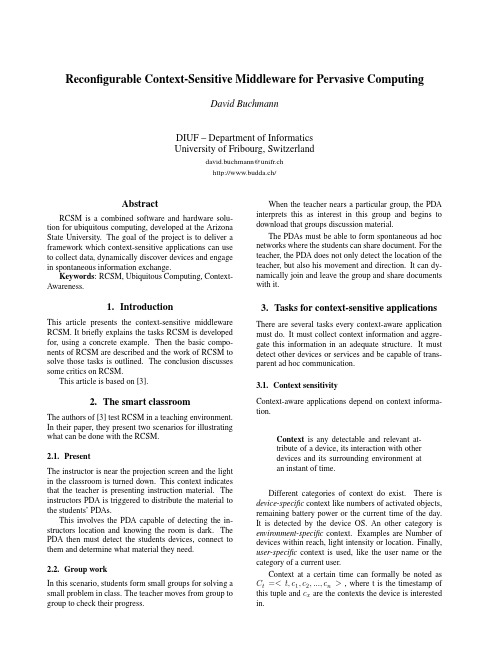
Reconfigurable Context-Sensitive Middleware for Pervasive ComputingDavid BuchmannDIUF–Department of InformaticsUniversity of Fribourg,Switzerlanddavid.buchmann@unifr.chhttp://www.budda.ch/AbstractRCSM is a combined software and hardware solu-tion for ubiquitous computing,developed at the Arizona State University.The goal of the project is to deliver a framework which context-sensitive applications can use to collect data,dynamically discover devices and engage in spontaneous information exchange.Keywords:RCSM,Ubiquitous Computing,Context-Awareness.1.IntroductionThis article presents the context-sensitive middleware RCSM.It briefly explains the tasks RCSM is developed for,using a concrete example.Then the basic compo-nents of RCSM are described and the work of RCSM to solve those tasks is outlined.The conclusion discusses some critics on RCSM.This article is based on[3].2.The smart classroomThe authors of[3]test RCSM in a teaching environment. In their paper,they present two scenarios for illustrating what can be done with the RCSM.2.1.PresentThe instructor is near the projection screen and the light in the classroom is turned down.This context indicates that the teacher is presenting instruction material.The instructors PDA is triggered to distribute the material to the students’PDAs.This involves the PDA capable of detecting the in-structors location and knowing the room is dark.The PDA then must detect the students devices,connect to them and determine what material they need.2.2.Group workIn this scenario,students form small groups for solving a small problem in class.The teacher moves from group to group to check their progress.When the teacher nears a particular group,the PDA interprets this as interest in this group and begins to download that groups discussion material.The PDAs must be able to form spontaneous ad hoc networks where the students can share document.For the teacher,the PDA does not only detect the location of the teacher,but also his movement and direction.It can dy-namically join and leave the group and share documents with it.3.Tasks for context-sensitive applications There are several tasks every context-aware application must do.It must collect context information and aggre-gate this information in an adequate structure.It must detect other devices or services and be capable of trans-parent ad hoc communication.3.1.Context sensitivityContext-aware applications depend on context informa-tion.Context is any detectable and relevant at-tribute of a device,its interaction with otherdevices and its surrounding environment atan instant of time.Different categories of context do exist.There is device-specific context like numbers of activated objects, remaining battery power or the current time of the day. It is detected by the device OS.An other category is environment-specific context.Examples are Number of devices within reach,light intensity or location.Finally, user-specific context is used,like the user name or the category of a current user.Context at a certain time can formally be noted as C t=<t,c1,c2,...,c n>,where t is the timestamp of this tuple and c x are the contexts the device is interested in.3.2.Situation awarenessAccording to[2],context-sensitivity is inadequate for ap-plications which need to analyse multiple contexts and users’actions over a period of time.The aggregated con-text information builds up a situation.Situation awareness is the capability of adevice to capture and analyse the relation-ship among multiple contexts and actionsover a period of time.While context just captures one instant of time,sit-uation is built of several context values and for a period of time.The context is analysed and accumulated into a situation.A situation also contains the notion of device be-haviour as consequence of it.3.3.Ad hoc communicationAd hoc communication is made over com-munication channels among application soft-ware that are instantaneously established andterminated due to changing contexts,devicemobility and resource availability.Ad hoc communication is normally started after some situation came true.RCSM uses this to speed up commu-nication,we will look at this later in this chapter.4.Parts of RCSMThis section explain the different part of RCSM which are used to fullfill the tasks mentioned above.RCSM was designed with existing,context-sensitive applications in mind.It hides the acquisition of context from the application.The framework waits for context-events and calls methods of a user-supplied object upon their arrival.Figure1shows the parts of an RCSM sys-tem.RCSM includes communication channels,not only for the applications,but also for context acquisition.A single device would be limited to the scope of its sensors. RCSM can share such context information.4.1.Interface DefinitionRCSM is used by defining an in the“Context-Aware In-terface Definition Language”(CA-IDL).This language can be used to describe context events and methods to call if some combination of the events occur.An interface compiler generates the Adaptive Object Container(ADC)which is used between RCSM and the user supplied object implementation that is called upon context events.The ADC periodically gets the necessary context data through the R-ORB(see below)to know if some situation cametrue.Figure2:IDL CompilerTo illustrate this,please seefigure2and the sample code for an interface://context sourceRCSMContext dc{char[]string location;boolean light;};//beginning context-sensitive interface interface instructor_object{//context variablesRCSMContext_var dc C1where location=screen;RCSMContext_var dc C2where light=true;RCSMContext_var dc C3where light=false;//context-sensitive method[outgoing][activate when C1ˆ($C2->C3$)]void distribute(string lectures); };//end of context-sensitive interface4.2.RCSM Object Request BrokerThe RCSM Object Request Broker(R-ORB)is the framework running on every RCSM device.It provides the transparent ad hoc communication,collects sensor data for the ADC and can connect to other R-ORBs.Figure1:Parts of RCSM(Source:[1])4.3.RCSM general inter-ORB protocolTo connect to other R-ORBs,the general inter-ORB pro-tocol(R-GIOP)is used.This protocol can be used by the R-ORB and abstracts from the underlying hardware used. (Infrared,Bluetooth,Ethernet etc.)4.4.HardwareThe RCSM team has chosen a combined Hardware-Software solution.While the user application and the ADC are in software,the R-ORB is implemented in Hardware.During development,a Field Programmable Gateway Array(FPGA)is used,resulting in a hardware block larger than the mobile device.The hardware architecture is shown infigure3.5.ConclusionUsing a framework for developing context-sensitive ap-plications seems a good idea as the context-acquiring tasks can be abstracted.Other presentations show alter-native frameworks.In this section,we will look at some benefits and also possible critics of RCSM.Afinal paragraph talks about general ubicomp critics.5.1.Benefits of RCSM5.1.1.Application DevelopmentDevelopment of context-sensitive applications is facili-tated quite a bit,as RCSM does all the standard jobs of managing communication,collecting sensor data and triggering actions.All the developer has to do is define the contexts,situ-ations and actions to take,and to implement those action.5.1.2.Ad hoc communicationThis sort of communication is facilitated and speeded up by a proactive device discovery.The R-ORB scans for devices in range.If two are found,the R-ORB check if they should es-tablish a channel.If the devices could communicate with each other,the channel is created.To be able to commu-nicate they must be in transmission range(reachability), must contain context-aware objects,have had some ADC that was activated recently(activation)and those ADC must have methods that can be called because they have the same interface signature(compatibility).Figure3:Hardware of RCSM(Source:[1])5.2.CriticsThe author did not have the opportunity to test RCSM, thus the critics are based on the mentioned documents only.5.2.1.Only one practical exampleThe RCSM team does its development using one single practical example,the“smart classroom”.This yields the risk that RCSM could get too specific to solve the class-room problems,while different areas are not well sup-ported.5.2.2.The hardware approachTo the author,the hardware approach seems not justified. The R-ORB could well run in software.Regarding the explosion of compute power on handheld devices,effi-ciency should not be a problem with modern devices.Additional hardware should only be required in form of sensors or communication devices.5.3.Basic critics on UbicompUbiquitous can facilitate our life,boring tasks may be avoided.It can be used in private as well as in the in-dustry.But with small computers penetrating in our lives everywhere,there are also some dangers.Lots of the examples in Ubicomp require many de-vices to be always-on.If every system must be running or on stand-by,this is a considerable waste of energy.Many devices being around to collected data of its users behaviour yields a risk of surveillance.It can be very easy to just collect data and not delete it when its no longer needed.6.References[1]Stephen S.Yau et.al.Adaptive Middleware forSituation-Aware Communication in Ubiquitous Com-puting Environments.Web site University of Ari-zona:/rcsm,2002.[2]Stephen S.Yau et.al.Development of Situation-Aware Application Software for Ubiquitous Comput-ing Environments.Proceedings of26th IEEE Inter-national Computer Software and Applications Con-ference(COMPSAC2002),August26-29,2002. [3]Stephen S.Yau et.al.Reconfigurable context-sensitive middleware for pervasive computing.IEEE Pervasive V olume:1Issue:3,July-Sept.,2002.。
第21章(1)教材配套课件
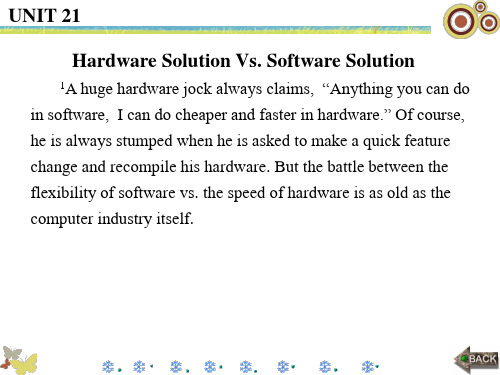
分析: “as”在此句中为连词, 意为“随着”, 引导时间状语 从句。
句意: 但是随着企业计算业的成熟, 形势已发生了根本的 改变。
UNIT 21
5. Buried into this chip are 70 new instructions that will greatly improve the performance of demanded features, such as speed input and video output.
UNIT 21
This race started in 1981 when MS-DOS used several software “trickery” to fake the hardware into exploiting certain features. 3These were important tricks needed to increase the speed of slow hard drivers, or to address more RAM than the processor was designed to access. But the secret of success for these solutions was the capability of Microsoft and other vendors to quickly develop software solutions. Software solutions always ran slower than their hardware counterparts, but were often completed years before hardware vendors could deliver their offering.
高三英语信息技术单选题50题
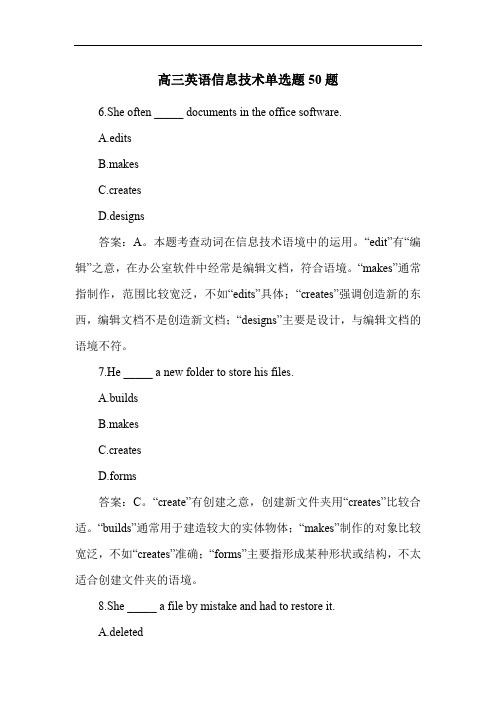
高三英语信息技术单选题50题6.She often _____ documents in the office software.A.editsB.makesC.createsD.designs答案:A。
本题考查动词在信息技术语境中的运用。
“edit”有“编辑”之意,在办公室软件中经常是编辑文档,符合语境。
“makes”通常指制作,范围比较宽泛,不如“edits”具体;“creates”强调创造新的东西,编辑文档不是创造新文档;“designs”主要是设计,与编辑文档的语境不符。
7.He _____ a new folder to store his files.A.buildsB.makesC.createsD.forms答案:C。
“create”有创建之意,创建新文件夹用“creates”比较合适。
“builds”通常用于建造较大的实体物体;“makes”制作的对象比较宽泛,不如“creates”准确;“forms”主要指形成某种形状或结构,不太适合创建文件夹的语境。
8.She _____ a file by mistake and had to restore it.A.deletedB.removedC.lostD.discarded答案:A。
“delete”表示删除,不小心删除了文件符合语境。
“removed”通常指移除某个物体,不一定是删除文件;“lost”是丢失,不一定是主动删除导致的;“discarded”侧重于丢弃不要的东西,不如“deleted”准确。
9.He _____ the file to another location.A.movedB.shiftedC.transferredD.carried答案:C。
“transfer”有转移、传送之意,把文件转移到另一个位置用“transferred”比较恰当。
“moved”和“shifted”比较笼统,没有“transfer”在信息技术语境中那么准确;“carried”通常指携带,不太适合文件转移的语境。
01review
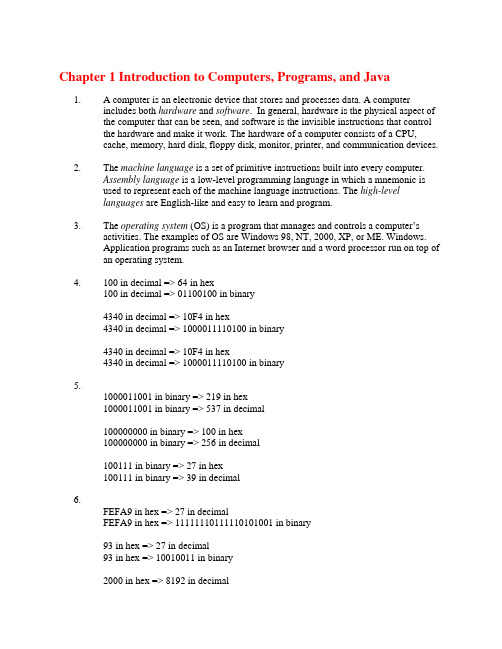
Chapter 1 Introduction to Computers, Programs, and Java1. A computer is an electronic device that stores and processes data. A computerincludes both hardware and software. In general, hardware is the physical aspect ofthe computer that can be seen, and software is the invisible instructions that controlthe hardware and make it work. The hardware of a computer consists of a CPU,cache, memory, hard disk, floppy disk, monitor, printer, and communication devices.2.The machine language is a set of primitive instructions built into every computer.Assembly language is a low-level programming language in which a mnemonic isused to represent each of the machine language instructions. The high-levellanguages are English-like and easy to learn and program.3.The operating system (OS) is a program that manages and controls a computer’sactivities. The examples of OS are Windows 98, NT, 2000, XP, or ME. Windows.Application programs such as an Internet browser and a word processor run on top ofan operating system.4.100 in decimal => 64 in hex100 in decimal => 01100100 in binary4340 in decimal => 10F4 in hex4340 in decimal => 1000011110100 in binary4340 in decimal => 10F4 in hex4340 in decimal => 1000011110100 in binary5.1000011001 in binary => 219 in hex1000011001 in binary => 537 in decimal100000000 in binary => 100 in hex100000000 in binary => 256 in decimal100111 in binary => 27 in hex100111 in binary => 39 in decimal6.FEFA9 in hex => 27 in decimalFEFA9 in hex => 11111110111110101001 in binary93 in hex => 27 in decimal93 in hex => 10010011 in binary2000 in hex => 8192 in decimal2000 in hex => 10000000000000 in binary7.Developed by a team led by James Gosling at Sun Microsystems in 1991. Originallycalled Oak, it became Java in 1995 when it was redesigned for developing Internetapplications.Java can run on any platform with a Java Virtual Machine. The minimum requirementis the Java Runtime Environment, free from the .8. The input is the Java source code and the output is the Java bytecode (if compiledsuccessfully).9. JBuilder by Borland, Sun ONE Studio by Sun, Café by WebGain, Visual Age forJava by IBM are the tools for developing Java programs, not dialects of Java. Thesetools make developing Java programs easier and more productive.10. HTML is a markup language for displaying static Web pages. Java is a full-fledgedprogramming language that can be used to develop dynamic Web pages. The Javaprograms that run from a Web browser are called applets. Java applets must beembedded in HTML files using the <applet> tag.11. Keywords have specific meaning to the compiler and cannot be used for otherpurposes in the program such as variables or method names. Examples of keywordsare class, static, and void.12. Java source code is case sensitive. Java keywords are always in lowercase.13. The source file extension is .java and the bytecode file extension is .class.14. Comments are used to document what a program is for and how a program isconstructed. Comments help the programmers or users to communicate andunderstand the program. Comments are not programming statements and are ignoredby the compiler. In Java, comments are preceded by two forward slashes (//) in a lineor enclosed between /* and */ in multiple lines. When the compiler sees //, it ignoresall text after // in the same line. When it sees /*, it scans for the next */ and ignoresany text between /* and */.15. System.out.println(...);JOptionPane.showMessageDialog(null, “Hello world”);16. Line 2. Main should be main.Line 2. static is missing.Line 3: Welcome to Java! should be enclosed inside double quotation marks.Line 5: The last ) should be }.17. javac is the JDK command to compile a program program. java is the JDK commandto run a program.18. Java interpreter cannot find the .class file. Make sure you placed the .class in the rightplace, and invoked java command with appropriate package name.19. The class does not have a main method, or the signature of the main method isincorrect.。
(0089)《专业英语》西南大学20年6月机考限时答案

西南大学培训与继续教育学院课程一、单项选择题(本大题共10小题,每道题2.0分,共20.0分)1.The OSI model has ( ) layersA.fourB.fiveC.sixD.seven2.Which one is not a computer languages?( )A.wordB.PythonC.CD.C++3.( ) is a word processing tool that helps you to create quality documents.A.WordB.OutlookC.AccessD.Excel4.( ) is a device that enables the computer to handel soundswork cardB.video cardC.sound cardD.monitor5.The RGB value is composed of ( ) componentsA.oneB.twoC.threeD.four6.( ) is a fast and powerful operating system, based on the UNIX O.S.A.WindowsB.OfficeC.WindowsD.Linux7.The purpose of the ( ) is to provide fully integrated analog services to user s.A.ISDNB.WWWC.FTPD.HTTP8.( ) is used to communicate with another computer over telephone lines.A.KeyboardB.ModernC.MouseD.Printer9.Virus is a ( )A.ProgramputerC.Bad manD.Beast10.The ( ) turns the object file into an executable programA.linkerpilerC.interpreterputer二、填空题(本大题共10小题,每道题3.0分,共30.0分)1.The year 2000 was a turning point in electronic commerce. It marked then end of the dot-com( )boom2.The three most commonly used categories of electronic commerce are B2C,( ) and business processes.B2B3.Most people use the terms electronic commerce and electronic ( )interchange ablybusiness4.The increase in ( ) connections in homes is a key element in the second wave of electronic commerce.broadband5.In computer security, integrity covers the two related concepts of ( ) inte grity and system integritydata6.When a consumer sells a good or service to another consumer, the model is calle d ( )cal7.In C2C transactions, one party is selling, and thus acting as a business, so th ey are sometimes treated as part of ( )electronic commerceC2C8.A ( )is a string of characters used for authenticating a user on a computer system.password9.Ecommerce, also known as electronic commerce or internet commerce, refers to the buying and ( )of goods or services using the internetselling10.Security concerns with respect to data encompass availability, secrecy, and ( )integrity三、判断题(本大题共5小题,每道题2.0分,共10.0分)1.We can use multimedia in Education, Entertainment and and so on.对错2.When you send an email you should provide the sender's email address对错3.Viruses can cause programs crashing but cant cause entire hard disk deleting对错4.The TCP/IP Internet protocol suite is formed from five standards对错5.Your computer uses two types of memory: primary meory and secondary memory对错四、翻译题(本大题共5小题,每道题8.0分,共40.0分)1.Please translate the following into ChineseBefore digital recording took over the audio and video industries, everything w as recorded in analog.在数字录音接管音频和视频行业之前,所有内容都以模拟形式录制。
高三英语询问技术创新单选题50题
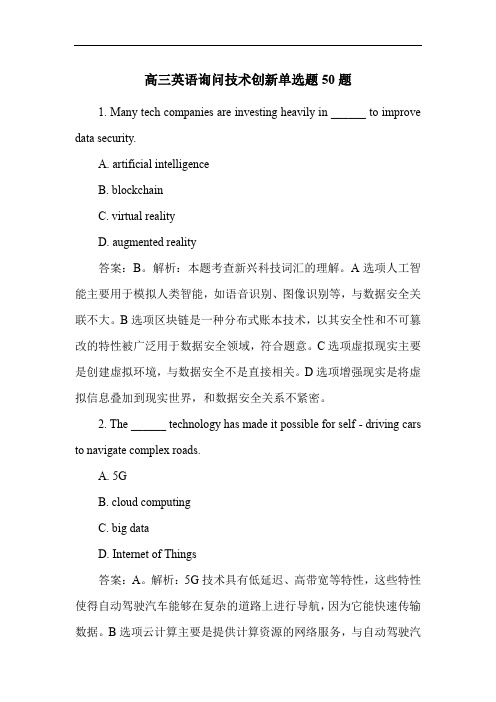
高三英语询问技术创新单选题50题1. Many tech companies are investing heavily in ______ to improve data security.A. artificial intelligenceB. blockchainC. virtual realityD. augmented reality答案:B。
解析:本题考查新兴科技词汇的理解。
A选项人工智能主要用于模拟人类智能,如语音识别、图像识别等,与数据安全关联不大。
B选项区块链是一种分布式账本技术,以其安全性和不可篡改的特性被广泛用于数据安全领域,符合题意。
C选项虚拟现实主要是创建虚拟环境,与数据安全不是直接相关。
D选项增强现实是将虚拟信息叠加到现实世界,和数据安全关系不紧密。
2. The ______ technology has made it possible for self - driving cars to navigate complex roads.A. 5GB. cloud computingC. big dataD. Internet of Things答案:A。
解析:5G技术具有低延迟、高带宽等特性,这些特性使得自动驾驶汽车能够在复杂的道路上进行导航,因为它能快速传输数据。
B选项云计算主要是提供计算资源的网络服务,与自动驾驶汽车导航关系不直接。
C选项大数据侧重于数据的收集、存储和分析,不是直接助力自动驾驶导航的关键。
D选项物联网强调设备之间的连接,并非自动驾驶汽车导航的最主要技术支持。
3. Tech startups are exploring the potential of ______ in the field of medical diagnosis.A. quantum computingB. gene editingC. nanotechnologyD. all of the above答案:D。
五金工具英语作文
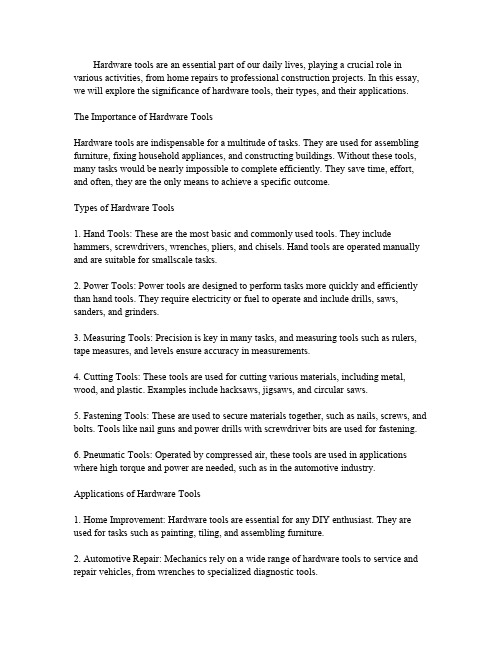
Hardware tools are an essential part of our daily lives,playing a crucial role in various activities,from home repairs to professional construction projects.In this essay, we will explore the significance of hardware tools,their types,and their applications.The Importance of Hardware ToolsHardware tools are indispensable for a multitude of tasks.They are used for assembling furniture,fixing household appliances,and constructing buildings.Without these tools, many tasks would be nearly impossible to complete efficiently.They save time,effort, and often,they are the only means to achieve a specific outcome.Types of Hardware Tools1.Hand Tools:These are the most basic and commonly used tools.They include hammers,screwdrivers,wrenches,pliers,and chisels.Hand tools are operated manually and are suitable for smallscale tasks.2.Power Tools:Power tools are designed to perform tasks more quickly and efficiently than hand tools.They require electricity or fuel to operate and include drills,saws, sanders,and grinders.3.Measuring Tools:Precision is key in many tasks,and measuring tools such as rulers, tape measures,and levels ensure accuracy in measurements.4.Cutting Tools:These tools are used for cutting various materials,including metal, wood,and plastic.Examples include hacksaws,jigsaws,and circular saws.5.Fastening Tools:These are used to secure materials together,such as nails,screws,and bolts.Tools like nail guns and power drills with screwdriver bits are used for fastening.6.Pneumatic Tools:Operated by compressed air,these tools are used in applications where high torque and power are needed,such as in the automotive industry.Applications of Hardware Tools1.Home Improvement:Hardware tools are essential for any DIY enthusiast.They are used for tasks such as painting,tiling,and assembling furniture.2.Automotive Repair:Mechanics rely on a wide range of hardware tools to service and repair vehicles,from wrenches to specialized diagnostic tools.3.Construction:The building industry heavily depends on hardware tools for tasks such as drilling,cutting,and assembling structures.4.Industrial Applications:In manufacturing and heavy industries,hardware tools are used for assembly,maintenance,and repair work.5.Agriculture:Farmers use hardware tools for various tasks,including the maintenance of machinery and the construction of agricultural structures.Safety and MaintenanceUsing hardware tools safely is paramount.This includes wearing appropriate protective gear,following the manufacturers instructions,and regularly maintaining the tools to ensure they remain in good working order.Proper maintenance prolongs the life of the tools and prevents accidents.ConclusionIn conclusion,hardware tools are a fundamental part of many industries and everyday tasks.Their versatility and necessity cannot be overstated.As technology advances,so too do the capabilities of hardware tools,making our lives easier and more efficient. Understanding the different types of hardware tools and their applications is crucial for anyone looking to undertake projects with confidence and success.。
英渭学习
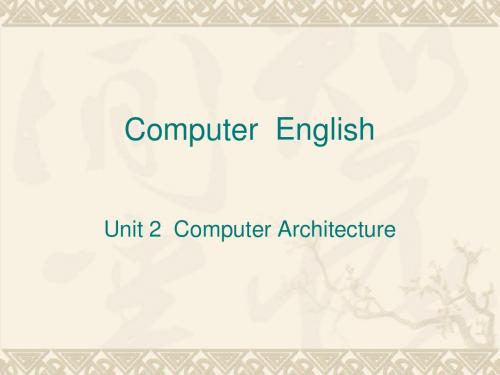
A mouse is a pointing device designed to be gripped by one hand. It has a detection device (usually a ball) on the bottom that enables the user to control the motion of an on-screen pointer, or cursor, by moving the mouse on a flat surface. As the device moves across the surface, the cursor moves across the screen. To select items or choose commands on the screen, the user press a button on the mouse.
输入硬件包含一些外部设备,即计算机中央处理器 之外的部件,它们能为计算机提供信息和指令。光笔 是一种带有光敏感笔尖的输入笔,它可用来在屏幕上 直接画图或通过按压光笔上的夹子或对着屏幕按压光 笔来选择屏幕上的信息。光笔包含能够识别光笔所经 过的屏幕部分的光敏感器。
stylus [‘stailəs] n. 输入笔,光笔
鼠标是设计为用一个手把握的点击设备,它的底部有 一个探测设备(通常是一个球),探测设备可使用户 通过在平面上移动鼠标来控制屏幕上指针或光标的移 动。当鼠标在平面上移动时,光标就在屏幕上移动。 为了选择屏幕上的项目或命令,用户只需按一下鼠标 上的按钮。
A joystick is a pointing device composed of a lever that moves in multiple directions to navigate a cursor or other graphical object on a computer screen. 控制杆是由一个杠杆组成的指示设备,该杠杆可以在 多个方向上移动来为计算机屏幕上的光标或其他图形 对象导航。
2024版Ansoft

目录
• Ansoft application in signal processing field
• Ansoft software operation guide and skill sharing
01 Ansoft Software Overview
Software background and characteristics
Parameter Studies
Allow users to perform parameter sweeps to optimize designs and understand the impact of different variables on performance
High Frequency Circuit Simulation
要点一
EMC Analysis
Ansoft enables engineers to perform electromagnetic compatibility (EMC) analysis to ensure that their designs comply with international EMC standards
Circuit Simulation
With Ansoft's advanced circuit simulators, engineers can design and analyze complex microwave and RF circuits, taking into account various parameters such as frequency response, noise figure, and linearity
中考英语现代科技应用单选题50题

中考英语现代科技应用单选题50题1. We can use a ______ to take photos, send messages and play games.A. calculatorB. smartphoneC. radioD. camera答案:B。
解析:本题考查现代科技设备相关词汇。
A选项“calculator”是计算器,主要用于计算,不能用来拍照、发信息和玩游戏;C选项“radio”是收音机,功能是收听广播等,与题干描述功能不符;D选项“camera”只能用于拍照,不能发送消息和玩游戏;而B选项“smartphone”智能手机可以实现拍照、发消息和玩游戏等功能。
2. If you want to type a document quickly, you should use a ______.A. printerB. scannerC. keyboardD. mouse答案:C。
解析:本题考查电脑相关部件的功能。
A选项“printer”是打印机,用于打印文件而不是输入文件;B选项“scanner”是扫描仪,主要功能是扫描;D选项“mouse”是鼠标,主要用于操作电脑界面的选择等;C选项“keyboard”键盘是用于快速输入文字来打字的。
3. My smartphone has run out of ______. I need to charge it.A. waterB. powerC. paperD. ink答案:B。
解析:本题考查智能手机的相关知识。
A选项“water”水与手机充电无关;C选项“paper”纸张是用于书写或打印的,和手机无关;D选项“ink”墨水是用于打印机等设备的,与手机无关;B选项“power”电量,手机没电了需要充电。
4. You can ______ the Internet on your computer to get information.A. connectB. cutC. breakD. stop答案:A。
软件工程选择判断
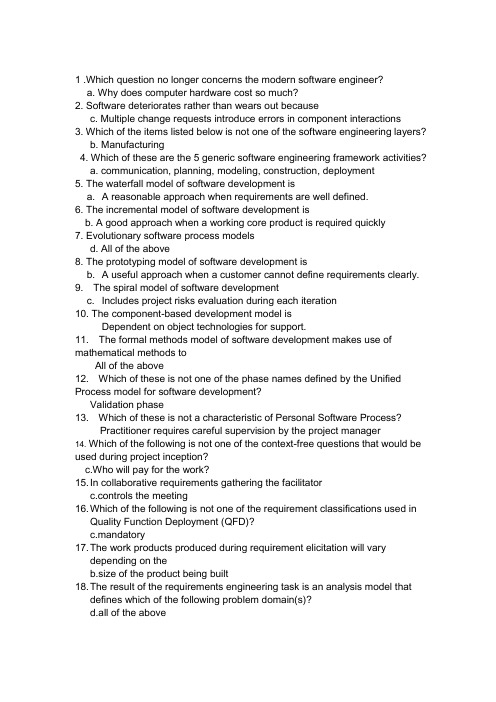
1 .Which question no longer concerns the modern software engineer?a. Why does computer hardware cost so much?2. Software deteriorates rather than wears out becausec. Multiple change requests introduce errors in component interactions3. Which of the items listed below is not one of the software engineering layers?b. Manufacturing4. Which of these are the 5 generic software engineering framework activities?a. communication, planning, modeling, construction, deployment5. The waterfall model of software development isa. A reasonable approach when requirements are well defined.6. The incremental model of software development isb. A good approach when a working core product is required quickly7. Evolutionary software process modelsd. All of the above8. The prototyping model of software development isb. A useful approach when a customer cannot define requirements clearly.9. The spiral model of software developmentc. Includes project risks evaluation during each iteration10. The component-based development model isDependent on object technologies for support.11. The formal methods model of software development makes use of mathematical methods toAll of the above12. Which of these is not one of the phase names defined by the Unified Process model for software development?Validation phase13. Which of these is not a characteristic of Personal Software Process?Practitioner requires careful supervision by the project manager14. Which of the following is not one of the context-free questions that would be used during project inception?c.Who will pay for the work?15. In collaborative requirements gathering the facilitatorc.controls the meeting16. Which of the following is not one of the requirement classifications used inQuality Function Deployment (QFD)?c.mandatory17. The work products produced during requirement elicitation will varydepending on theb.size of the product being built18. The result of the requirements engineering task is an analysis model thatdefines which of the following problem domain(s)?d.all of the above1. Which of these is not an element of a requirements model?c.Data elements2. Which of the following is not an objective for building a requirementsmodel?c.develop an abbreviated solution for the problem3. UML activity diagrams are useful in representing which analysis modelelements?d.Scenario-based elements4. The entity rlationship diagrama.depicts relationships between data objects5. Which of the following should be considered as candidate objects in aproblem space?d.all of the above6. Which of the following is not one of the broad categories used to classifyoperations?d.transformers7. Which of the following items does not appear on a CRC card?c.class reliability8. Class responsibilities are defined byd.both its attributes and operations9. Control flow diagrams area.needed to model event driven systems.10. For purposes of behavior modeling an event occurs wheneverb.the system an actor exchange information.11. For purposes of behavior modeling a state is anyc.observable mode of behavior.12. The state transition diagramd.indicates system reactions to external events13. Which is not one of the analysis activities that is used to create a completeanalysis model?d.Market analysis6. What are the elements of a WebApp interaction model?e-cases, sequence diagrams, state diagrams, interface prototype1. Which of the following are characteristics of testable software?d.all of the above2. The testing techniqe that requires devising test cases to demonstrate thateach program function is operational is calleda.black-box testing3. The testing technique that requires devising test cases to exercise theinternal logic of a software module is calledd.white-box testing4. The cyclomatic complexity metric provides the designer with informationregarding the number ofc.independent logic paths in the program5. Condition testing is a control structure testing technique where the criteriaused to design test cases is that theyb.exercise the logical conditions in a program module6. Data flow testing is a control structure testing technique where the criteriaused to design test cases is that theyc.select test paths based on the locations and uses of variables7. Loop testing is a control structure testing technique where the criteria usedto design test cases is that theyd.focus on testing the validity of loop constructs8. Test derived from behavioral class models should be based on thestate transition diagram9. Real-time applications add a new and potentially difficult element to thetesting mixd.time1. To determine the architectural style or combination of styles that best fitsthe proposed system, requirements engineering is used to uncoverb.characteristics and constraints2. Which of the following is not an example of infrastructure components thatmay need to be integrated into the software architecture?c.Interface components3. When the overall flow in a segment of a data flow diagram is largelysequential and follows straight-line paths _________ is present.d.transform flow4. When a single item that triggers other data flow along one of many paths________ characterizes the information flow in a segment of a data flow diagram is present.c.transaction flow。
第一章Computer Hardware
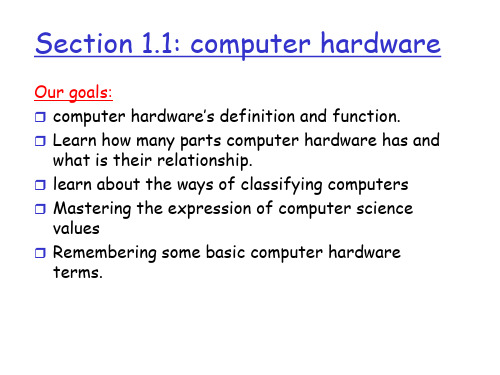
Main memory Central processing unit(CPU)
Computers classification (1)
According to the function purpose, computer is
classified as:
General-purpose machine:it can solve many different kinds
KEYWORDS
Computer
Information
Input device Output device Main memory Central processing unit Bus Microcomputer Minicomputer
processing Hardware Software Program General-purpose machine Special-purpose machine Instruction Set of instruction
Input
Processing
Output
Fig.1-1 The three activities of a computer system
The components of computer systems and their relation
The lines between the blocks represent the flow of
Main memory
Bus
Fig.1-2 block diagram of the four components of a computer system
中考英语科技前沿探索单选题40题
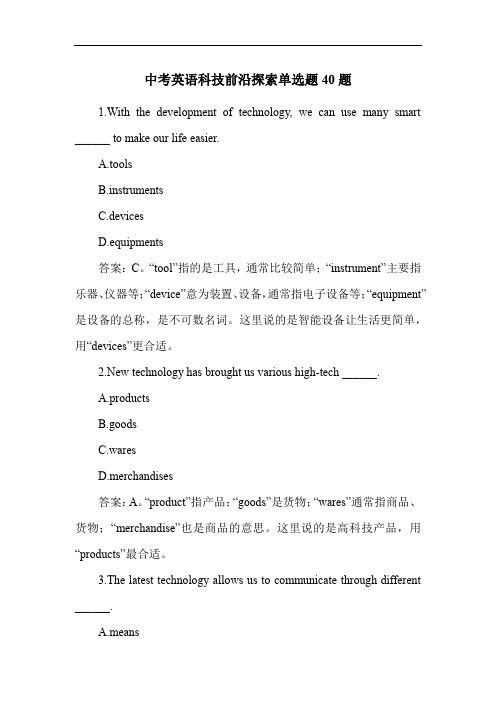
中考英语科技前沿探索单选题40题1.With the development of technology, we can use many smart ______ to make our life easier.A.toolsB.instrumentsC.devicesD.equipments答案:C。
“tool”指的是工具,通常比较简单;“instrument”主要指乐器、仪器等;“device”意为装置、设备,通常指电子设备等;“equipment”是设备的总称,是不可数名词。
这里说的是智能设备让生活更简单,用“devices”更合适。
2.New technology has brought us various high-tech ______.A.productsB.goodsC.waresD.merchandises答案:A。
“product”指产品;“goods”是货物;“wares”通常指商品、货物;“merchandise”也是商品的意思。
这里说的是高科技产品,用“products”最合适。
3.The latest technology allows us to communicate through different ______.A.meansB.waysC.methodsD.approaches答案:A。
“means”侧重于方式、手段,常与介词by 搭配;“ways”比较常用,强调做事的方法;“methods”强调系统的方法;“approaches”指接近的方法、途径。
这里说的是通过不同的方式交流,“means”更符合科技前沿的语境。
4.Technology has created many new ______ for entertainment.A.channelsB.pathsC.avenuesD.courses答案:C。
“channels”指频道、渠道;“paths”是小路、路径;“avenues”有途径、渠道的意思,这里表示娱乐的新途径;“courses”是课程、路线。
初三英语科技发明单选题40题
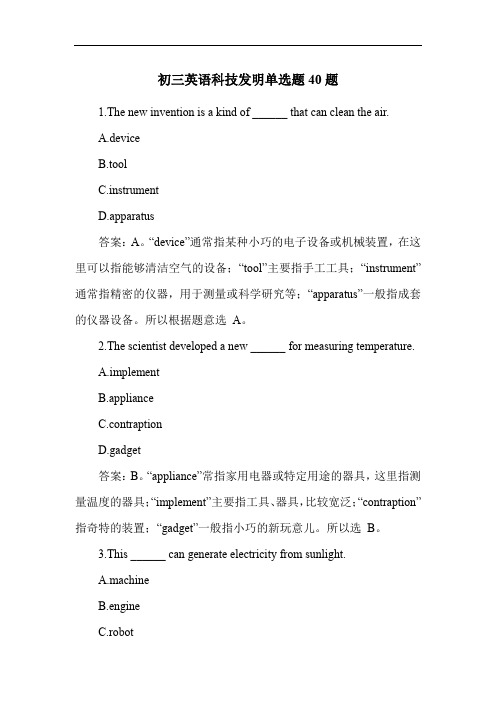
初三英语科技发明单选题40题1.The new invention is a kind of ______ that can clean the air.A.deviceB.toolC.instrumentD.apparatus答案:A。
“device”通常指某种小巧的电子设备或机械装置,在这里可以指能够清洁空气的设备;“tool”主要指手工工具;“instrument”通常指精密的仪器,用于测量或科学研究等;“apparatus”一般指成套的仪器设备。
所以根据题意选A。
2.The scientist developed a new ______ for measuring temperature.A.implementB.applianceC.contraptionD.gadget答案:B。
“appliance”常指家用电器或特定用途的器具,这里指测量温度的器具;“implement”主要指工具、器具,比较宽泛;“contraption”指奇特的装置;“gadget”一般指小巧的新玩意儿。
所以选B。
3.This ______ can generate electricity from sunlight.A.machineB.engineC.robotputer答案:A。
“machine”可以指各种机器,这里指能从阳光中产生电能的机器;“engine”主要指发动机;“robot”是机器人;“computer”是电脑。
所以选A。
4.The company has invented a new ______ to make cars more fuel-efficient.A.mechanismB.systemC.structureanization答案:B。
“system”可以指系统、体系,这里指让汽车更省油的系统;“mechanism”指机械装置、机制;“structure”指结构;“organization”指组织。
科技英文作文产品
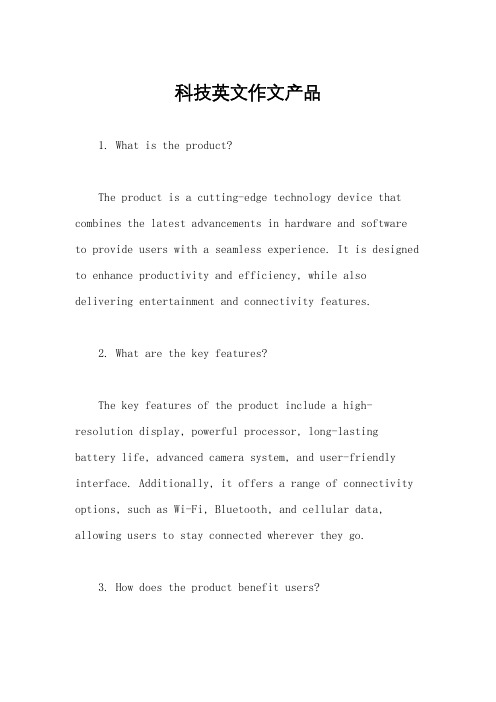
科技英文作文产品1. What is the product?The product is a cutting-edge technology device that combines the latest advancements in hardware and software to provide users with a seamless experience. It is designed to enhance productivity and efficiency, while also delivering entertainment and connectivity features.2. What are the key features?The key features of the product include a high-resolution display, powerful processor, long-lasting battery life, advanced camera system, and user-friendly interface. Additionally, it offers a range of connectivity options, such as Wi-Fi, Bluetooth, and cellular data, allowing users to stay connected wherever they go.3. How does the product benefit users?The product benefits users by providing them with a versatile and reliable device that can be used for avariety of purposes, such as work, entertainment, and communication. Its advanced features and capabilities allow users to accomplish more in less time, while also staying connected with friends, family, and colleagues.4. What sets the product apart from competitors?What sets the product apart from competitors is its combination of cutting-edge hardware and software, along with its intuitive and user-friendly design. It offers a range of features and capabilities that are unmatched by other devices, making it the preferred choice for users who demand the best in terms of performance and functionality.5. How does the product contribute to the advancement of technology?The product contributes to the advancement of technology by pushing the boundaries of what is possible with hardware and software. Its innovative features andcapabilities inspire other companies to develop new and exciting products, driving progress and innovation in the tech industry.。
科技英语翻译答案123
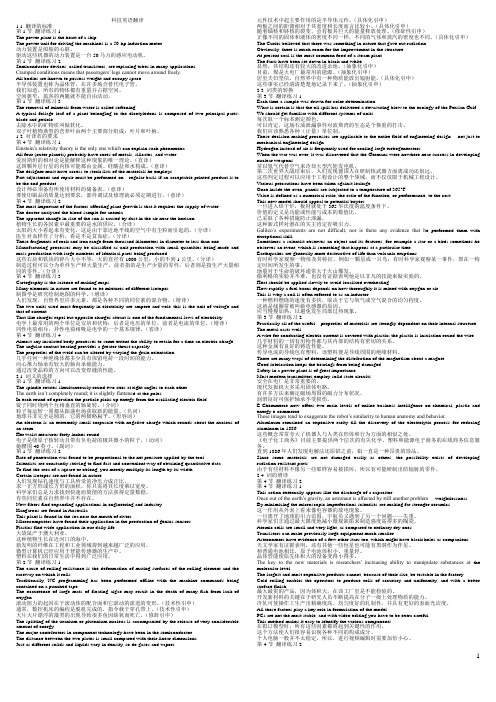
科技英语翻译1.1 翻译的标准第1节翻译练习1The power plant is the heart of a ship.The power unit for driving the machines is a 50-hp induction motor.动力装置是船舶的心脏。
驱动这些机器的动力装置是一台50马力的感应电动机。
第1节翻译练习2Semiconductor devices, called transistors, are replacing tubes in many applications.Cramped conditions means that passengers’ legs cannot move around freely.All bodies are known to possess weight and occupy space.半导体装置也称为晶体管,在许多场合替代电子管。
我们知道,所有的物体都有重量并占据空间。
空间狭窄,旅客的两腿就不能自由活动。
第1节翻译练习3The removal of minerals from water is called softening.A typical foliage leaf of a plant belonging to the dicotyledons is composed of two principal parts: blade and petiole.去除水中的矿物质叫做软化。
双子叶植物典型的营养叶由两个主要部分组成:叶片和叶柄。
1.2 对译者的要求第4节翻译练习1Einstein’s relativity theory is the only one which can ex plain such phenomena.All four (outer planets) probably have cores of metals, silicates, and water.爱因斯坦的相对论是能解释这种现象的唯一理论。
- 1、下载文档前请自行甄别文档内容的完整性,平台不提供额外的编辑、内容补充、找答案等附加服务。
- 2、"仅部分预览"的文档,不可在线预览部分如存在完整性等问题,可反馈申请退款(可完整预览的文档不适用该条件!)。
- 3、如文档侵犯您的权益,请联系客服反馈,我们会尽快为您处理(人工客服工作时间:9:00-18:30)。
A Hardware/Software Approach to Molecular Dynamics on ReconfigurableComputersRonald Scrofano,Maya Gokhale,Frans Trouw,and Viktor K.PrasannaUniversity of Southern California,Los Angeles,CALos Alamos National Laboratory,Los Alamos,NMrscrofan,prasanna@,maya,trouw@AbstractWith advances in reconfigurable hardware,especially field-programmable gate arrays(FPGAs),it has become possible to use reconfigurable hardware to accelerate com-plex applications,such as those in scientific computing. There has been a resulting development of reconfigurable computers—computers which have both general purpose processors and reconfigurable hardware,as well as memory and high-performance interconnection networks.In this pa-per,we study the acceleration of molecular dynamics simu-lations using reconfigurable computers.We describe how we partition the application between software and hard-ware and then model the performance of several alterna-tives for the task mapped to hardware.We describe an implementation of one of these alternatives on a reconfig-urable computer and demonstrate that for two real-world simulations,it achieves a2speed-up over the software baseline.We then compare our design and results to those of prior efforts and explain the advantages of the hard-ware/software approach,includingflexibility.1IntroductionReconfigurable hardware,in the form of FPGAs,has been used successfully in the acceleration of many appli-cations and application tasks.Previously,FPGAs were lim-ited to performing tasks that required onlyfixed-point arith-metic.However,recent advances in FPGA hardware,in-cluding increased density and the inclusion of embedded multipliers,have madefloating-point arithmetic on FPGAs possible.Several libraries for performingfloating-point arithmetic on FPGAs have been developed[4,5,6].An exciting challenge is to use FPGAs to accelerate scientific This work is supported by Los Alamos National Laboratory under contract/award puting applications that are very computationally inten-sive and requirefloating-point arithmetic.One particularly interesting scientific computing appli-cation to investigate is molecular dynamics(MD)simula-tion.MD is a technique that models the movements of atoms in a substance over time.Tasks in the simulation include calculating forces,updating positions and veloci-ties,and other supporting tasks.All of these calculations are traditionally performed in single-or double-precision floating-point arithmetic.One task in an MD simulation—the nonbonded force calculation—is very computationally intensive while the other tasks are less intensive or have complicated control logic.It makes sense,then,to acceler-ate the nonbonded force calculation in reconfigurable hard-ware while executing the rest of the simulation with a gen-eral purpose processor.In this paper,we describe designing and implementing an MD simulation system using such a hardware/software approach.The implementation platform is a reconfigurable computer that has both general purpose processors and re-configurable hardware.Wefirst develop a software imple-mentation that has most of the important tasks in an MD simulation but is not as complex as large MD software pack-ages such as GROMACS and NAMD[8,16].We then par-tition the tasks in the simulation such that the most intensive is executed in reconfigurable hardware and the rest are exe-cuted by the general purpose processor.This hardware/software approach to acceleration is the key to developing a more complete simulation system than previous acceleration efforts that moved all tasks of the sim-ulation into hardware[3,7].It takes into account the fact that not all tasks in a large scientific program,such as a program for MD simulation,are good candidates for ac-celeration.Tasks which are control-intensive or which can be executed very efficiently by general purpose processors should be left in software.Acceleration efforts should be targeted towards those tasks whose acceleration will have the greatest impact on the performance of the overall al-gorithm.Another advantage of the hardware/software ap-proach is that it allows for incremental acceleration of the application.That is,once even a single task is implemented in hardware,the application is accelerated.Other tasks may be accelerated later to provide even greater speed-ups,but at no time is functionality lost.In a hardware-only approach, the entire application must be accelerated before any ben-efit is realized.Similarly,the hardware/software approach gives the system theflexibility to easily integrate new tasks for advanced simulations.These canfirst be integrated as software,then,if necessary,accelerated with hardware.In the next subsection,we describe reconfigurable com-puters.In Section2,we introduce MD simulations and de-scribe our software.In Section3,we describe the hard-ware/software partitioning.We then model several alterna-tives for the reconfigurable hardware implementation and decide,based upon estimated performance of the whole ap-plication,which to implement.In Section4,we describe our implementation on a reconfigurable computer and com-pare its performance to that of the pure software approach and to that predicted in Section3.We discuss related work and compare it to ours in Section5.Finally,in Section6, we draw some conclusions and discuss future directions.1.1Reconfigurable ComputersReconfigurable computers are comprised of both gen-eral purpose processors and FPGAs,as well as high-performance,low-latency interconnect between them.The FPGAs act as programmable application accelerators for the general purpose processors.Reconfigurable computers are ideal for executing applications that contain both control-intensive portions,which execute on the general purpose processors,and data-intensive portions,which execute on the FPGAs.While in this work we use a single general pur-pose processor and a single FPGA,the high-performance nature of reconfigurable computers makes them well-suited for use in large clusters and supercomputers.In this paper,we will consider one specific reconfig-urable computer:the SRC6e MAPstation[15].The SRC6e MAPstation has two2.8GHz Intel Xeon processors;a MAP processor,which has two Xilinx Virtex-II FPGAs available for custom designs;and a high-performance interface con-necting them.The choice of which portions of the applica-tion execute on which processing devices is left up to the designer.The development environment supports the de-sign of accelerators in C,Fortran,VHDL,and Verilog.2Molecular DynamicsMD is a widely used technique for simulating the move-ments of atoms in a system over time.The number of atoms in a system varies widely,from about10000atoms in small simulations to over a billion atoms in the largest simula-tions.In this section,we provide background information about MD,the reference for which is[1].In an MD simulation,each atom in the system has an initial position and velocity at time.Given the initial properties of the system,the MD simulation de-termines the trajectory of the system from time to some later time.In the process,the simulation keeps track of properties such as temperature and total energy.In order to compute the system’s trajectory,the positions of all the atoms at time are calculated based on the positions of all the atoms at time,where is a small time interval,typically on the order of one femtosecond.One of the most popular methods for calculating new positions is the velocity Verlet algorithm.The steps in this algorithm are,for each atom1.calculate based on and acceleration;2.calculate based on;3.calculate based on andfor all atoms;4.calculate based on.The most time-consuming part of the simulation is up-dating the acceleration.The acceleration comes from the forces acting upon each of the atoms.2.1Force CalculationThe forces in an MD simulation can be grouped in two categories:bonded and nonbonded.Bonded forces—namely bond stretch,angle bend,and dihedral torsion—only occur between atoms that are bonded to one another. Thus,each atom only interacts with a few other atoms and the computation of bonded forces is not a bottleneck.Nonbonded forces,on the other hand,can occur be-tween any two atoms in a simulation that are not part of the same bond.The two types of nonbonded forces most often used in MD simulations are the forces due to the Lennard-Jones and Coulomb potentials(hereafter referred to as the Lennard-Jones force and the Coulomb force,respectively). Equation1must be evaluated for every atom in a sim-ulation tofind the nonbonded force acting on atom.The first two terms of the equation make up the Lennard-Jones force and the third makes up the Coulomb force.is the distance vector between atoms and and is the magni-tude of,i.e.,the distance between atoms and.and are constants that depend on the types of atoms and. is the charge on atom.(1)In practice,it is common to use Newton’s Third Law,namely that,to reduce the number of calcula-tions.So for each pairwise force calculated,is added to and subtracted from.When calculating the Lennard-Jones forces,a cutoff dis-tance is always employed.That is,LJ is only calculatedif is less than some distance.There are severalmethods for calculating the Coulomb force,including cutoffCoulomb,which uses the same cutoff technique as is usedfor Lennard-Jones forces,Ewald summation,and ParticleMesh Ewald(PME).One of the difficulties of nonbonded force calculation isthat each pair of atoms may interact.Naively,this wouldrequire evaluations at each step,as the distance be-tween each atom and every other atom must be checked.Two techniques to reduce the number of pairs that must beevaluated are the linked cell list and the Verlet neighbor list.In the linked cell list approach,the simulation box is bro-ken into a number of cells,where the length,width,andheight of each cell is close to but greater than the cutoff dis-tance.The atoms in each cell,then,only interact with atomsin the same cell or the26neighboring cells.This drasticallyreduces the number of pairs of atoms that must be evaluated.The purpose of the neighbor list is to avoid searching forinteracting pairs of atoms at every time step.It is based onthe principle that if atoms and are close at time step, they should still be close at time step.So,the neighborlist is built at time step and updated at time step, where is commonly between10and20.The neighbor list is really a combination of lists,where each atom has a list of atoms with which it might interact.Throughout the paper,when we refer to“the neighbor list,”we mean the all-encompassing combination of lists.When we refer to “atom’s neighbor list,”we are referring to only the list of atom’s neighbors.The list can be constructed using either the search for pairs or the more efficient linked cell list approach.Thefirst step in implementing the MD simulation appli-cation on a reconfigurable computer is to develop a softwareimplementation that can be profiled and eventually modifiedto make use of the reconfigurable hardware.2.2Software ImplementationFor our work,we have written a software implementa-tion of a molecular dynamics simulation.This softwareimplements the Velocity Verlet algorithm in single or dou-ble precision arithmetic.For nonbonded force calculation,we calculate the Lennard-Jones force and use the cutoffCoulomb technique for the Coulomb force.During forcecalculation,we also calculate the potential energy.For bet-ter accuracy,we use shifted forces and potential energies toremove discontinuities in the force and potential energy at the cutoff distance[1].Doing so adds the need for two moretype-based constants and several extrafloating-point oper-ations to the force calculation.To identify the interactingpairs of atoms,we use the Verlet neighbor list technique.Every steps,where is defined by the user,a linked cell list is created.This linked cell list is then traversed to makethe neighbor list.We have also implemented the bondedforce calculation,referencing[2]while doing so.The inputs to the simulation are provided at run-time.They include the number of steps in the simulation,thelength of the time step,the dimensions of the simulationbox,the cutoff and neighbor list cutoff distances,and thefrequency at which the neighbor list should be updated.AnAmber-format topologyfile can be used to specify the struc-ture of the system[2].This specification includes the types,charges,and masses of the atoms,the groups of atoms thatparticipate in bonded interactions,and constants used inboth bonded and nonbonded force calculation.The initialpositions of the atoms in the system can be specified in acoordinatefile in PDB format[11].The software is written in C.It has been compiled us-ing Intel’s C compiler,version8.1.We profiled the single-precision version of the software running two benchmarksimulations for1000steps each.We ran the simulationson one of the2.8GHz Xeon processors in the MAPstation.The operating system is Linux.To profile,we used Oprofileversion0.8.1[9].Table1shows the profiling results.2.2.1Notes on the ImplementationThe simulations described in this paper follow conventionalmethodologies as used in the simulation community.Thereare a two approximations made.One is the use of single-precisionfloating-point arithmetic.While our purely soft-ware version can use single-or double-precision,the taskrunning in reconfigurable hardware is limited to single-precision,as will become evident in the following section.The use of double-precision arithmetic is the conven-tional approach in MD simulations,although the widelyused GROMACS software is often used with single-precision arithmetic[16].The original driver for usinghigh precision arithmetic was the desire to avoid cumula-tive rounding errors implicit in very long simulations,butthis has been of less concern in recent work.Unless diver-gence from the“exact”atomic trajectories is important,asystem using single-precision arithmetic will still explorerealistic configurations during the simulation[12].The other approximation is the cutoff Coulomb approachfor the Coulomb forces.This is more of a concern thanusing single-instead of double-precision arithmetic.Re-cent simulations that compare the structure of biologicallyinspired model membrane structures have demonstratedthat the bilayer structures of cells are different at approx-Table1.Profile of the software implementa-tion for two benchmark simulations%of Computation Time Task Palmitic Acid CheY Protein Nonbonded Forces75.1574.09 Building Neighbor List20.7522.76 Dihedral Torsion Forces 2.14 1.51 Other 1.96 1.64 imately the5%level compared to when more sophisticated approaches such as PME are used[10].There are also indi-cations that the cutoff Coulomb approach creates incorrect structures for simulations of solvated proteins and DNA. However,this effect is still only at the5%level or less,and for some simulations the computational efficiency inherent in this approach makes it the only realistic choice.2.3Benchmark SimulationsAs benchmarks,we use simulations of palmitic acid and the CheY protein.Palmitic acid self-assembles into a one-molecule-thickfilm on water.There is very detailed experi-mental information that describes the atomic level structure of thisfilm,and we are simulating such monolayers to see whether the current parameterization of the interatomic in-teractions used in simulations can reproduce this behavior.In this simulation,there are52558atoms of8different types.The timestep for the simulation is2fs.The cut-off distance is10˚A and the neighbor list cutoff distance is 12˚A.The neighbor list is built once every10steps.The simulation box is˚A.The interest in simulating the dynamics of the CheY pro-tein is the surprising observation that microbial life forms can exist in very hot environments.There are many variants of this protein and we are simulating two variants to come to an understanding of their differing thermal stabilities.In this simulation,there are32932atoms of17different types.As is the case for palmitic acid,the timestep is2fs, the cutoff distance is10˚A,the neighbor list cutoff distance is12˚A,and the neighbor list is built once every10steps. The simulation box is˚A.3Design EvaluationFrom the profile in Table1,it is clear that accelerat-ing the computation of nonbonded forces would benefit the overall application most.But,before implementing the non-bonded force calculation in reconfigurable hardware,we need to determine if doing so will provide a significant speed-up for the overall application.To make this determi-nation,we model the performance of reconfigurable com-puter implementations before implementing them.We model the reconfigurable computer as consisting of two types of nodes:general-purpose-processor(GPP) nodes and reconfigurable-hardware(RH)nodes.GPP nodes consist of one or more general purpose processors and memory.RH nodes consist of reconfigurable hardware, likely in the form of one or more FPGAs,and on-board memory banks.Tasks in the application execute on either a GPP node or an RH node,but not both.In order for a task to execute on a particular node,the data needed by the task must reside in the node’s memory.If it does not,it must be transferred there,incurring a communication cost.In this paper,we are using one general purpose proces-sor on a single GPP node and one FPGA on a single RH node.Further,we are only moving one task to the RH node. Let SWtasks be the time taken by the tasks executing in soft-ware,comm be the time required to transfer the necessary data,and RH be the time taken by the nonbonded force calculation executing in reconfigurable hardware.The total time required to perform a step of the MD simulation on a reconfigurable computer is given by the sum of SWtasks, comm,and RH.Finding SWtasks is trivial:we simply use the profil-ing data from the software-only version of the application. Finding comm is also fairly simple:we determine how much data is transferred from/to GPP node to/from RH node and then divide by the bandwidth available between the two nodes.Determining RH is more challenging.RHis affected most by the parallelism and pipelining of the design.Parallelism is limited by the available logic resources of the reconfigurable hardware and the per-cycle bandwidth between the reconfigurable hardware and its on-board memory.Data dependencies and hazards involved with accessing local memory can cause pipeline stalls that are detrimental to the overall performance.Taking these factors into account,it is possible to esti-mate the number of cycles a design will require to produce a result.Estimates for achievable frequency can then be used to determine the execution time.3.1System-Level DesignAt the system level,the partitioning of the MD simula-tion algorithm between hardware and software is as shown in Figure1.At each time step,the current atomic positions need to be transferred to the RH node’s on-board memory. Each position vector has three components.So,if is the number of atoms and is the number of bytes perfloating-point word,bytes must be transferred to the RH node’s on-board memory.Further,the neighbor list must be trans-ferred to the RH node,although it should be possible to stream it to the RH node,thus overlapping the communica-Figure1.Hardware/software partitioning ofthe MD simulation applicationtion with computation.The reconfigurable hardware must also have access to the types and charges of each atom, which are constant throughout the simulation but vary fromsimulation to simulation.Several other values that are con-stant throughout the simulation must be available as well,such as the size of the simulation box and the constants inthe Lennard-Jones force equations.As the nonbonded forces are calculated,they will bestored in the RH node’s on-board memory.The force actingon each atom has three components,so the amount of datathat needs to be stored is.At the end of the nonbonded force calculation,this data will be transferred back to theGPP node.Therefore,ignoring the time taken to transferdata that remains constant since it is only transferred onceand ignoring the time to transfer the neighbor list since weassume that it will be streamed,the total communicationtime,comm,is GPP,RH s/step,where GPP,RH is thebandwidth between the GPP node and the RH node.3.2RH Node-Level Design AlternativesThe basic design for performing the nonbonded forcecalculation task on the RH node is a direct translation ofsoftware into hardware.The algorithm and architecturefor such a design are shown in Figures2and3,respec-tively.Though omitted in thefigures,the type and chargeof each atom is also used in the calculation.In thefigures,positionOBM and forceOBM represent on-board mem-ories.In Figure2,CALC NBF represents applying the shifted force version of Equation1andfinding the poten-tial energy,as well as other necessary techniques,such as the minimum image convention[1].In this design,the two loops in the algorithm arepipelined such that in every cycle,either a new atom is en-tering the pipeline or a new atom is entering the pipeline. If,the results of the calculation are discarded at the end of the pipeline.In Figure3,the“force calculation”box represents this pipeline.One problem with this design is that in orderto subtract a newly calculated from, needs to be read from the force memory.If,as is common inforeach atom do1positionOBM[]2forceOBM[]3foreach neighbor of do4positionOBM[]5if then6CALC NBF(,)78forceOBM[]9forceOBM[]10end11end12forceOBM[]13end14Figure2.Algorithm for basic designFigure3.Architecture for basic designpresently available reconfigurable computers,the on-board memory on the RH node is single ported,the pipelined ar-chitecture will have to stall for one cycle.There may also be penalties associated with switching the memory between read mode and write mode.Because of the lengthy pipelines infloating-point cores, this design is also susceptible to a read-after-write hazard. Specifically,the subtraction in line10of the algorithm may still be taking place for one atom when another atom causes the read in line9to execute.Since it is not possible to forward values within thefloating-point cores,stalling will be necessary.The time required to do the calculations with this design, in cycles,is given in Equation2.is the length of the neighbor list and is average the number cycles of stalling due to conflicting memory accesses and hazards.Put an-other way,on average,the pipeline produces one new result every cycles.RH(2)A second alternative is to use a write-back design.The algorithm for this design is given in Figure4.This design makes use of the fact that an atom occurs in atom’s neighbor list at most once.The loop beginning on line5ispipelined,as is the loop in beginning on line16.The outerloop is not pipelined.The key is that the new values arenot stored directly into on-board memory but instead arestored temporarily in on-chip memory(forceRAM).Theyare not written back to on-board memory until all of theneighbors of the current atom have been processed.Be-cause force calculation for a new atom cannot begin untilafter all of the atoms from the previous atom’s neighbor list have been written back to memory,the read-after-write hazard is avoided.The conflicting memory accesses of the basic design are also avoided.The number of times that the on-board memory switches modes is also minimized.The drawback to this design is that it requires that the pipeline be drained after the processing of each atom.Thus,the pipelinefill-up latency is incurred for each atom.To lessen the number of pipeline stages that must bedrained after each atom,the pipelined inner loop can be broken into two separate pipelines joined by a FIFO.This FIFO must be large enough to hold all of the neighbors of two(or more)consecutive atoms.Thefirst pipeline reads the position,charge,and type data for each neighbor atom and calculates.If,,the charge of,and the type of are written to the FIFO.Note that there are no de-pendencies at this stage,so this pipeline can write new val-ues to the FIFO as long as there is space.When the FIFO is full,it waits until the second pipeline has processed data be-fore it starts writing new values.The second pipeline reads data from the FIFO and does the remaining steps in the force calculation.This pipeline must be drained after each new atom that it reads from the FIFO.Since thefirst pipeline should produce data faster than the second pipeline can pro-cess it,there should be data ready in the FIFO whenever the second pipeline is ready to begin processing it.Effectively, then,it is only the second pipeline that must be drained and whosefill-up latency is incurred for each atom.The time required to do the calculations with this design,in cycles,is given in Equation3,where is the numberof atoms,is the average number of neighbors for eachatom,is the number of pipeline stages(if two pipelines are used,can be considered the number of stages in the second pipeline),and is the number of cycles required to switch an on-board memory from read mode to write mode and vice versa.Thefirst term in Equation3gives the number of cycles spent in the(second)pipeline.The second term gives the number of cycles spent writing data back to memory,as-suming these writes can be pipelined.The third term gives the number of cycles spent reading atoms’data from mem-ory.The last term gives the number of cycles spent switch-ing the on-board memory between read and write modes.RH(3)The last design alternative does not use that. The algorithm is the same as that in Figure2,except withoutforeach atom do1positionOBM[]2forceOBM[]34foreach neighbor of do5if then6positionOBM[]7CALC NBF(,)89forceOBM[]10forceRAM[]1112end13end14forceOBM[]15foreach in forceRAM do16forceOBM[]17end18end19Figure4.Algorithm for write-back design lines9and10.This design requires twice as many force calculations but removes the hazards and the need to read from the force memory.A caveat is that using this method will require use of a second neighbor list:if is a neighbor of in the original list,then must be a neighbor of in the second neighbor list.The time required to do the cal-culations with this design,in cycles,is given in Equation4, where BNL,GPP is the amount of time it takes to build the extra neighbor list on the general purpose processor.While this latter time is incurred by a task taking place on the gen-eral purpose processor,we include it here to emphasize that this method requires building the second neighbor list.RH BNL,GPP(4)Note that Equations2,3,and4,assume that there is enough bandwidth between the reconfigurable hardware and its on-board memory to read all three components of the positions,as well as the types and charges in parallel, while writing all three components of the forces in parallel.3.3Choosing a Design for the ImplementationWe now use Equations2,3,and4to determine which design we should use in our reconfigurable computer im-plementation.We are only able to do the nonbonded force computation in single-precision arithmetic on the reconfig-urable ing double precision arithmetic would require more logic than is available in the FPGAs in the MAPstation.Even if the amount of logic were sufficient,。
